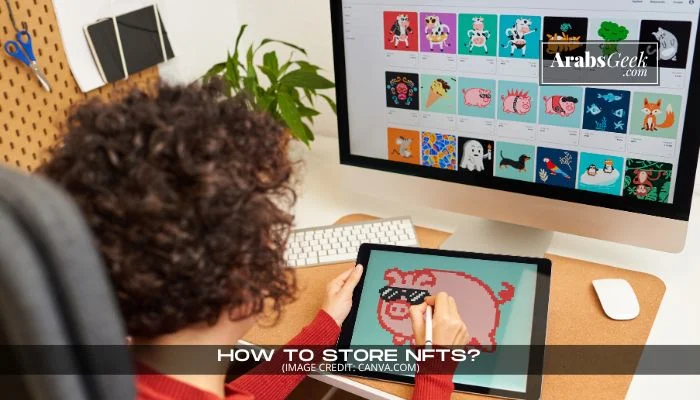How to Store NFTs? Venturing into the vibrant world of NFTs (Non-Fungible Tokens) is an exhilarating experience, but it brings up a crucial question: how do you securely store these valuable digital assets? Just as you wouldn’t leave a priceless painting unprotected, storing NFTs safely is key to preserving their value and ensuring your peace of mind. Unlike traditional art, NFTs don’t hang on your wall; they reside in the digital realm, which demands a different approach to security and storage.
Whether you’re a digital art aficionado, a collector of virtual collectibles, or an investor in this cutting-edge space, knowing how to store your NFTs is as essential as acquiring them. It’s not just about keeping them safe; it’s about understanding the intersection of technology and ownership in the digital age. With the right storage strategy, your digital treasures can be protected, accessible, and enjoyed for years to come.
Ready to discover the best ways to secure your slice of digital artistry? Let’s dive into the world of NFTs and explore the most effective methods to store and safeguard your valuable digital assets.
Table of Contents
Understanding NFT Storage | How to Store NFTs?
Storing Non-Fungible Tokens (NFTs) is about securing the digital keys that prove your ownership of these unique assets. Unlike physical items, NFTs exist on the blockchain, and their safety depends largely on how you manage your digital wallet and keys.
Types of Wallets for NFT Storage | How to Store NFTs?
- Hot Wallets: These are online wallets, easily accessible and convenient for regular transactions. Examples include MetaMask, Coinbase Wallet, and Trust Wallet. While user-friendly, they are generally less secure than cold wallets since they are connected to the internet.
- Cold Wallets: Cold wallets are offline storage options, like hardware wallets or paper wallets. They are more secure, as they are less vulnerable to online hacking. Hardware wallets like Ledger or Trezor are popular choices for their balance of security and accessibility.
- Unlock Exclusive Financial Insights! Click Over to EntrepreneursPilot.com Now!
- Unlock a Treasure Trove of Must-Read Finance Articles! Click Here to Dive into Our Homepage’s Wealth of Knowledge!
- Unlock Exclusive Business Opportunities! 🚀 Connect with Us Now at [email protected]!
Best Practices for Secure Storage | How to Store NFTs?
- Use Reputable Wallets: Choose wallets from reputable providers with a proven track record for security.
- Keep Your Private Keys Private: Never share your private keys or seed phrase with anyone. Losing control of your keys means losing your NFTs.
- Backup Your Wallet: Regularly backup your wallet, especially if you are using a hot wallet. This can be done by writing down the seed phrase or private key and storing it securely.
- Consider Using Multiple Wallets: For added security, use multiple wallets. Keep most of your NFTs in a cold wallet for long-term storage and a hot wallet for active trading and transactions.
- Regular Software Updates: Keep the wallet software up-to-date to protect against vulnerabilities.
- Be Cautious of Phishing Attacks: Be vigilant about phishing attempts and suspicious links that might try to steal your wallet information.
Understanding the Role of the Blockchain | How to Store NFTs?
Remember, the actual NFT is stored on the blockchain, and what you store in your wallet are the keys to access and control it. The blockchain’s decentralized nature ensures that your NFT is not stored in a single location, enhancing its security.
Transferring NFTs to a Wallet | How to Store NFTs?
- Set Up Your Wallet: Choose and set up your preferred wallet.
- Transfer NFTs: Transfer NFTs from the marketplace or another wallet to your wallet using your wallet’s address. Ensure the wallet supports the blockchain on which your NFTs exist.
- Verify the Transfer: Always double-check the wallet addresses and confirm the transfer on the blockchain for peace of mind.
The Importance of a Recovery Plan | How to Store NFTs?
Having a recovery plan is crucial. This includes keeping a backup of your seed phrase or private key in a secure location, like a safe or a safety deposit box, and possibly informing a trusted family member or legal advisor about how to access it in case of an emergency.
Deciding Between Hot and Cold Wallets | How to Store NFTs?
The choice between hot and cold wallets depends on your usage and security preference. If you actively trade NFTs, a hot wallet provides more convenience. For long-term investment, a cold wallet offers better security.
Considerations for High-Value NFTs
For high-value NFTs, enhanced security measures are advisable. This might include using multi-signature wallets or employing additional layers of physical security for your cold wallets.
Staying Informed About Security Trends
The digital landscape is ever-evolving, and staying informed about the latest security trends and threats is vital. Regularly educate yourself about new security practices and potential vulnerabilities in the NFT space.
Conclusion | How to Store NFTs?
Storing NFTs securely is a critical aspect of owning these digital assets. By choosing the right type of wallet, practicing vigilant security measures, and staying informed, you can ensure that your valuable NFTs remain safe and under your control.
FAQ Section
Q1: Can I recover my NFTs if my wallet is hacked?
A: Recovery is difficult if your wallet is hacked and private keys are stolen. Prioritize preventive measures like using secure wallets and keeping keys private.
Q2: Should I use the same wallet for NFTs and cryptocurrencies?
A: You can, but it’s often recommended to have separate wallets for different asset types for organization and security reasons.
Q3: How often should I backup my wallet?
A: Regular backups are essential, especially if you frequently add new NFTs to your wallet. Always backup after adding significant assets.
Q4: Are paper wallets safe for storing NFTs?
A: Paper wallets can be safe if created and stored correctly, but they are less convenient and more prone to physical damage than hardware wallets.











